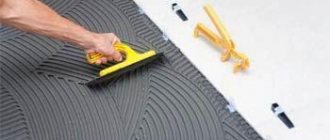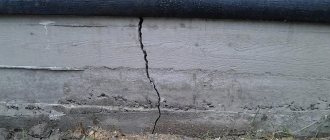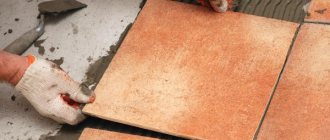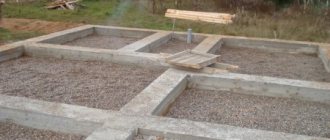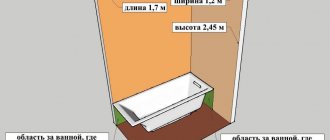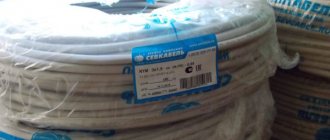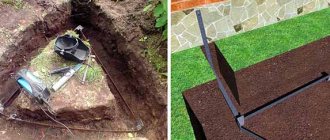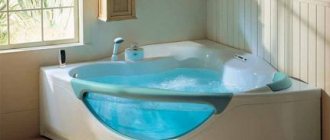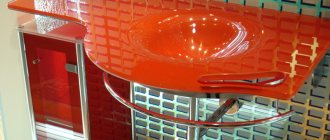Before you begin any repair work, you need to create a schedule. It all usually starts with the floors. Therefore, you need to calculate the time it will take for this part of the room. If you prefer self-leveling mixtures, then there are some factors to consider. Among others, we should highlight those that affect the drying of materials. Among others:
- number and final thickness of layers;
- type of finishing coating;
- type of dry composition;
- additives used;
- humidity and temperature in the room.
What topcoat to use
As for the finishing coating, it can be:
- linoleum;
- laminate;
- tile.
To speed up the polymerization of self-leveling floors and their further operation, some rules should be taken into account. Firstly, the composition must be evenly distributed over the surface. Although the material is called self-leveling, it needs help. To ensure that the level of the solution is the same, you should use a long and short spatula.
Conditions for normal floor drying
If you are wondering how long it takes for a self-leveling floor under a laminate to dry, you can find this information below in the article. However, in order to be sure that drying will take exactly the time indicated in the instructions, you should follow simple rules. For example, the indoor humidity level should be kept between 60 and 65%.
Drying time
If you, like many home craftsmen, are interested in the question of how long it takes for a self-leveling floor under a laminate to dry, then you must understand the base of the coating. The polymerization period will depend on this. For example, quick-drying solutions have good technical properties and short drying times. This usually takes from 2 to 5 hours. But as for cement-based coatings, they are usually used in private construction. They contain additives, plasticizers and cement. This floor can harden in 1 to 2 weeks.
You may also be interested in how long it takes for a self-leveling floor under a laminate to dry. If the material is polymer, then it is usually used in industrial construction. Drying time in this case ranges from 2 to 6 days. The final value is influenced by the number of layers and their thickness, as well as the presence of additives and special pigments. You can also use a polyurethane compound. It is durable and strong. A person will be able to move on such a floor in at least 10 hours. Complete hardening should be expected on the third day.
If, after visiting a building materials store, you wondered how long it takes for a self-leveling floor under a laminate to dry, then you should know that gypsum mixtures, also called anhydrite, are not recommended for use in rooms with high humidity. This should include toilets and bathrooms. This is explained by the fact that such material does not have the quality of moisture resistance. You will be able to walk on the plaster floor in two days, and install furniture in 10.
If you want to choose a floor with high wear resistance, you should prefer an epoxy composition. The polymerization time will depend on the number of layers and the final thickness of the coating. On average, polymerization takes from 2 to 5 days. Quite often, store shoppers wonder how long a self-leveling floor should take to dry. If you have a coating with a 3D effect, the curing time will depend on the image parameters.
If film or vinyl paper is used for decoration, the topcoat can be applied immediately. When the design is applied with paint, drying time may increase. The drying time of the glossy layer and the hardening period of the topcoat are of great importance. The drying time of a 3-D floor is about 7 days. The period can be shortened by using a quick-drying composition.
Hardening time depending on the type of coating
Self-leveling floors are divided into several types, depending on their composition. The drying speed primarily depends on the type of mixture you choose for pouring. For example, cement-based mortars take the longest to dry. Such mixtures are mainly used for installing floors in garages, industrial premises, industrial and utility buildings. Cement-based mixtures include plasticizers, dyes, various additives and fillers. It takes more than seven days for a coating made from this self-leveling mixture to dry.
For floor installation in residential premises, it is preferable to use polyurethane mixtures. They are durable and high quality. You can move on a coating made of this composition within 15–20 hours, and after two days it will dry completely. In this case, the drying time is reduced with decreasing layer thickness. There are also epoxy mixtures. They are elastic and resistant to various external influences. It will take about five days to wait for complete drying.
Today, self-leveling floors with a three-dimensional image (3D) are in fashion. This coating is poured in several layers. The floor takes about a week to dry on average. But it is worth considering that the drying time depends on what material the design is made of: film or paper. Also, the time during which the 3D coating will dry is affected by the rate of hardening of the polymer layer, which is applied second, and the protective coating (varnish).
Dependence of drying time on topcoat
Self-leveling floors are intended for installation under laminate, linoleum or tiles. The polymerization period also depends on the type of finishing material. If you plan to lay linoleum, then it is better to use a polyurethane composition, because it can be used within 3 days after pouring. You may also be interested in how long it takes for a self-leveling floor to dry if you lay it under a laminate. For this, it is better to use gypsum, polymer or polyurethane compounds.
Cement mixtures are usually used for tiles. Complete hardening can be expected within two weeks. The drying period depends on the quality of mixing the mixture and its uniform distribution. Otherwise, some areas may dry faster, while others will take about 12 more hours. Before pouring the floor, you should pay attention to the characteristics of the room. This should include:
- quality of the base;
- humidity;
- temperature.
These factors affect the drying time of floors. The choice of mixture should depend on the type of topcoat. This should be taken into account when choosing self-leveling floors.
Creating a self-leveling floor
To create such a rough surface, a self-leveling solution should be used before laying linoleum. It is made on the basis of polymer components. Self-leveling flooring is easy to do. It is enough to remove old materials, clean the surface, and prepare the required volume of the composition from the dry mixture.
Next, the floor is filled with mortar, which must be distributed over the entire area and smoothed well. The self-leveling floor will gain strength within a few days, after which you can proceed to laying the floor covering itself.
Review of manufacturers
Before making a choice in favor of one or another self-leveling floor, you should pay attention to how long it takes for the self-leveling floor to dry under the tiles. An excellent example would be the products of several, which are laid up to 5 mm thick and can be used for walking after 3 hours. The coating can be applied every other day at least. "Osnovit Mastline T-48", which can have a thickness from 3 to 80 mm, is used for further laying of tiles or laminate. In the first case, work on applying the topcoat can be completed after 3 days, in the second - after 7 days. You will be able to walk on this surface in just 4 hours.
Quite often, buyers ask sellers how long it takes for the Eunice self-leveling floor to dry. If you are looking at its “Eco” variety, which is based on gypsum, then you can lay tiles on such a surface in just five days, and laminate or parquet in 7 days. Material with a thickness of 10 to 100 mm is poured. And you will be able to walk on such a surface within 4 hours after completion of the work.
How long does it take for the self-leveling floor “Starateli” to dry? This question may also interest you, because this product is quite popular among consumers. If you have a thin self-leveling floor, you can lay the decorative coating in a couple of weeks, and walk on it in 8 hours. The thickness of the final layer of the rough surface can range from 1 to 20 mm.
When choosing a mixture, you must distinguish between two concepts - the period of strength development and drying time. The second assumes the possibility of foot traffic, while the first requires intensive constant use. Manufacturers let customers know when the finished screed floor can be walked on and when to start applying the finishing coat. In this regard, you may be interested in how long it takes for a self-leveling floor under linoleum to dry. If you have the universal mixture Ivsil Tie-Rod-I, then the drying time for laying the mentioned coating is 14 days. The same amount of time will be spent on drying the universal composition Weber Vetonit 4100.
Laying linoleum
Laying linoleum on an adhesive base
In conclusion, a few words about laying linoleum itself. When purchasing linoleum, you should know that the best option would be a material with a thickness of four millimeters. It will last longer and already has insulation. It is best to start work at a room temperature of plus fifteen degrees, because in cold weather linoleum can be easily damaged. If the material is purchased in one roll, then it can be laid without using glue; it will be enough to press it around the perimeter with floor skirting boards and special thresholds in the doorway.
If there are several pieces, then they are stacked one by one. After waiting for the glue to dry on one piece, you can lay the next one, and this must be done overlapping; the excess edges are then cut off with a stationery knife. If there is an uneven distance between the walls in the room, then the overlap should be done on all walls. In this case, it is necessary to ensure that the pattern matches. And if the pattern in the next room is the same, you will have to achieve the greatest coincidence of the pattern in the doorway.
If bubbles appear here and there, they are pierced with a needle and then smoothed with a roller. The glue dries within 24 hours. If seams are still observed, they can be eliminated by gluing with a special compound.
Pouring technology and reviews
During the process of pouring the self-leveling mixture, it will be necessary to form an underlying layer. According to consumers, this allows you to reduce the filling consumption by half. If you are using a polymer floor, its thickness should not exceed 5 mm. After the layer is poured onto the surface, air bubbles must be removed from its thickness. The most convenient way to do this is to use, as home craftsmen emphasize, a needle roller. Then you can start applying the top coat. You can distribute the composition at this stage using a squeegee.
Why do you need a liquid floor under linoleum?
Liquid flooring creates a reliable and level foundation. It is almost impossible to find a perfectly level floor with a rough finish in a room.
To level the surface, today you can find many types of starting liquid compositions on the market. These are mixtures that allow you to create a reliable base that does not shrink. They help level the floor with a thin, perfectly even layer and ensure a high degree of adhesion of the front finish to the base. Liquid flooring under linoleum is also good because it can be installed independently, without the involvement of specialists. Such floors are impact-resistant, environmentally friendly, and fire resistant. The composition includes a gypsum or cement mixture and a filler containing additives that give the solution moisture-proofing characteristics, make the solution plastic and quickly harden. In general, self-leveling floors installed under linoleum are smooth, even and elastic. The durability and attractiveness of the coating depends on such qualities.
Preparatory work
Tools for working with self-leveling coating
First of all, you should know on what base the floor will be poured.
Gypsum self-leveling floor. Pouring self-leveling mixtures
- If it is a wooden base, then it must be clean and dry, and have some roughness. To create roughness, you can use sandpaper. Using tools, remove all existing traces of paint and glue, after which the floor should be vacuumed and degreased. There is no need to prime this floor.
- If you already have linoleum and you decide to replace it with a new one, then it is advisable to dismantle it. But there are times when the old base is firmly glued to the floor and cannot be removed. In this case, it is possible to pour the mixture directly onto the old coating, having previously cleaned it of dirt and degreased it. After which you should apply the self-leveling floor to the linoleum and sand it thoroughly.
- Ceramic tiles should not be removed before laying linoleum. But if some elements have fallen off, then they need to be glued in place, and then filled with solution.
- If linoleum is to be laid on a concrete base, then the top layer should be removed and the surface sanded. All existing potholes, cracks and crevices must be sealed with putty. Spreading, the solution will fill the recesses existing on the surface, but then the consumption of the mixture increases significantly, which will lead to unwanted unnecessary costs. To work you will need the following tools:
- several clean buckets;
- putty knife;
- toothed roller;
- needle roller;
- paint shoes;
- solvent for cleaning instruments;
- level.
Pouring the floor
Pouring the solution and rolling it out with a needle roller
To increase the adhesion of the self-leveling floor to the concrete base, use a primer, which is applied with a wide brush or roller. It is also necessary to prevent the appearance of fungus in the future. The primer is applied once; if the surface is porous, then several layers are applied. Primer should be done in a well-ventilated area.
Important! Any mixture for self-leveling floors consists of several elements that must be mixed evenly, while following the recommendations on the packaging. Errors in proportions can degrade the performance of the mixture. It is important that the mixture is poured into a container with clean water, and not vice versa.
An electric drill with attachments is usually used for mixing. The resulting solution is left for a few minutes to allow excess air to escape and mixed again. The resulting mixture should be viscous, without lumps or layers of water.
The layer of self-leveling floor should not exceed five millimeters. If the area of the room is large, more than twenty square meters, the floor should be filled in sections adjacent to each other and leveled with a wide spatula. The finished mixture spreads perfectly, having a plastic liquid structure, is evenly distributed over the entire plane of the base and hardens in an absolutely flat and uniform state.
Note: When performing work and during hardening, the room temperature should not exceed plus twenty-five degrees, and humidity should not exceed eighty percent. At higher rates, the hardening time will increase, and condensation may appear on the floor surface. It is highly desirable that the self-leveling floor be poured in one go.
They go over the solution with a spiked roller, this is done in order to remove all the air bubbles that have formed. To walk on the floor you need to use paint shoes. The self-leveling floor should be protected from exposure to sunlight. After complete drying, about seven days, you can proceed to installation.
Uneven self-leveling floor. What to do?


